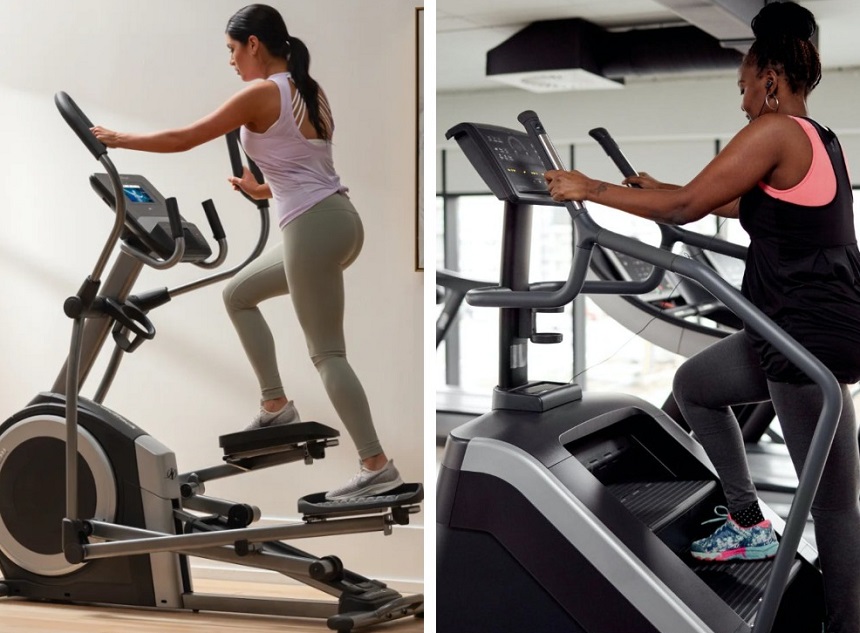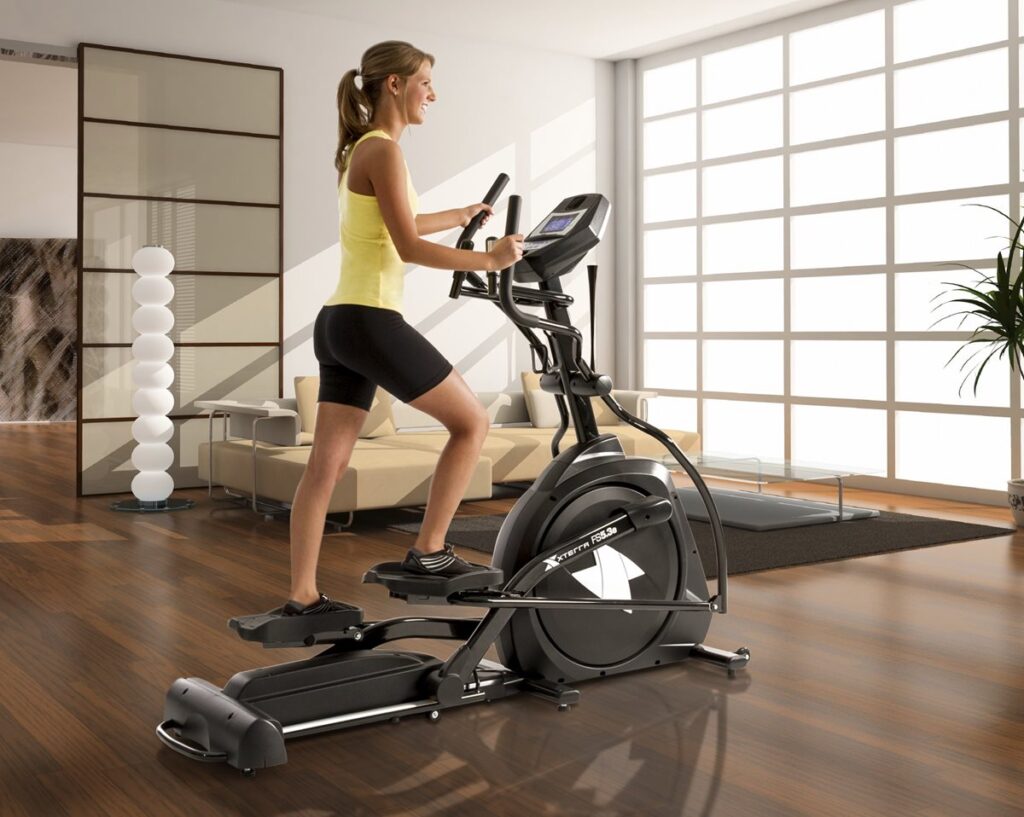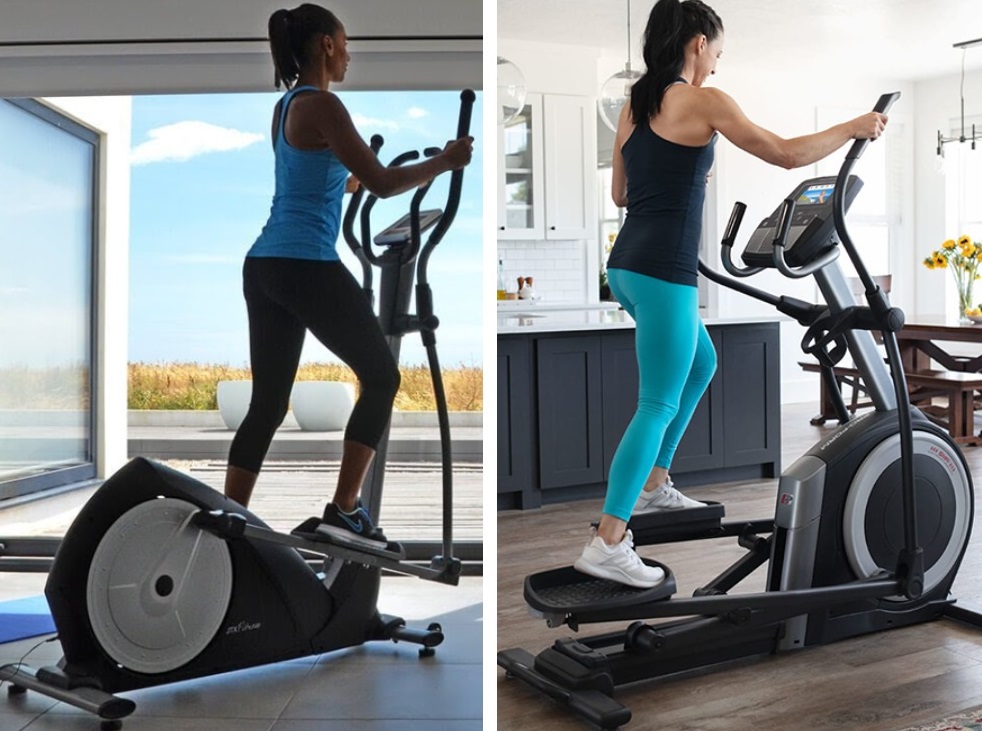An elliptical trainer is versatile and a popular machine for aerobic exercise that is low-impact because it does not place excessive strain on your joints and muscles as jogging on a pavement would. The equipment features movable handles and pedals that provide effective cardio workout for both upper and lower body muscles. Elliptical machines are also compact and ideal if you have limited space. There are different types of ellipticals on the market and we will discuss all the available options as well as their respective advantages.
We will also explain how to use an elliptical machine for cardiovascular exercise that will burn calories and help with weight loss, improve your stamina and balance and reduce hip and back pain by lubricating your joints. Lastly, we will recommend what to look for when choosing the best type of elliptical machine for your needs.
The different kinds of elliptical machines mainly come in 3 major styles depending on the placement of the flywheel and drive; front drive, center drive and rear drive. Below we will explain each category and the key differences including the design, features, pros and cons. We will also examine whether the location of the flywheel makes a difference in getting the best elliptical workout since that has been an ongoing debate.
This type of elliptical machine that looks similar to a traditional exercise bike came up later as an alternative to rear drive machines after Precor patented his design.
The motor or flywheel system powers an elliptical machine by spinning and creating resistance as you pedal. This part is located on the front of the machine of this second-generation elliptical design. Front drive ellipticals are mostly common in home gyms.
The front placement of the motor gives this type of elliptical machines a less flat movement pattern that feels like you are climbing stairs or walking uphill. They also have a wide range of incline that can also be intense if that is what you are looking for and models like XTERRA Fitness FS3.5 come with multiple pre-set workout programs and support for MP3 player to liven your workout session. You lean more toward the front of the equipment because of the inclined position.
Different kinds of elliptical machines vary in how they operate. Front drive trainers bounce forward and backward as oppose do rear drive trainers that bounce up and down. They come with more moveable components to produce the elliptical motion. Subsequently, these machines are more likely to break down and require more maintenance.
However, they are more affordable than rear drive models and their compact design takes up less floor space during operation.
Additionally, front drive elliptical trainers are more sophisticated and some come with Bluetooth connectivity and multiple workout programs.
Pros
Cons
The relatively smaller design of front drive elliptical machines makes it suitable for home use. Unfortunately, the small footprint does not allow for a longer and more natural stride that is more effective at working your muscles properly. Besides checking that all the moving components are tightened, you would also need to use lubricants to reduce noise and to ensure smooth operation. Otherwise, this type of elliptical machine is the best for improving your balance and coordination. It is also a better option for those with limited mobility because the design is a bit lower to the ground and easy to step on the machine. The best shoes for elliptical trainers would also keep you comfortable, especially during long sessions.
Among the different types of ellipticals based on motor placement, center drive design is the less common but most recent variation. It has a square design as opposed to a long rectangle.
The location of the flywheel on either side of the pedals makes this type of elliptical machine more compact than front and rear drive machines, and a popular choice for home use. They provide vertical or horizontal movements but a more vertical range of motion similar to front drive models that feels like climbing stairs while still allowing you to remain more upright. Their narrow pedal spacing reduces strain on hip and knee joints.
Pros
Cons
Center drive elliptical trainers feature the newest technology that is suitable for low-impact and longer cardio sessions. Their drawback is the higher cost but there are reasonably priced ones like Body-Solid E400 which has an adjustable stride from 17 to 21 inches and weight capacity of 300 pounds to accommodate most individuals.
Rear drive elliptical trainers are the oldest prototype that was designed in 1990 by Precor who believed it had a smoother motion and improved the stability of the machine. This type is mostly found in gyms. It features the drive system or flywheel at the back which lends the equipment a different feel that is more flat or level. The flatter movement feels more natural because it is like you are jogging or walking on flat ground instead of on a slope or hill. You can stand straight and you don’t have to lean forward like when you are using a front drive machine that has a less upright design. It also allows for more walking and running.
Rear drive ellipticals feature holders for water bottles and accessories and movable handles that you use for upper body exercise. This type of elliptical machine bounces up and down and has a more circular pedal movement than other trainers. Most of them also come with incline settings that allow you to elevate the front of the machine but the inclination is less intense than the one provided by front drive elliptical trainers. For instance, NordicTrack SpaceSaver SE7i features an adjustable power ramp for incline workouts, a 10-year warranty and 30-day iFIT membership.
Another difference between front drive and rear drive trainers is that the latter provides more stride lengths and has a simpler design that is less prone to breakdown and easier to fix because of fewer moving components. It is also less noisy. However, rear drive elliptical machines take up more space and they are also more expensive.
Pros
Cons
We recommend rear drive elliptical machines for beginners. The equipment is easy to operate. Set the machine on flat ground, choose your desired program and start pedaling. Press the pause or Reset button key to stop pedaling.
The different kinds of elliptical machines are also categorized in terms of size and functions. We will examine these variations in this section.
Also known as a foldable elliptical machine, this type is the lightest format and you can fold it after use to significantly reduce its size for storage although the storage size will depend on the stride length and handlebar.
The equipment features a display, movable handlebar and flywheel mechanism on the front or back side. Cubii JR2 includes a digital monitor and adjustable resistance setting.
Pros
Cons
This is the most common type of elliptical machines. It has foot pedals and a handlebar but its handlebar is not movable like other elliptical variations. This means that a standard elliptical primarily focuses on lower body workouts. You pedal in a circular motion to exercise your glutes, quads and hamstrings, and the level of intensity will depend on the location of the flywheel on the machine.
According to this study Trusted Source Comparison of elliptical training, stationary cycling, treadmill walking and overground walking - PMC The most common functional motor goal of lower extremity rehabilitation is to improve walking ability. For reasons of feasibility, safety or intensity, devices are frequently used to facilitate or augment gait training. The objective of this study was to compare the muscle activity patterns of the quadriceps and hamstring muscles during four conditions: overground walking, treadmill walking, stationary cycling, and elliptical training. www.ncbi.nlm.nih.gov , elliptical training is more effective at muscle activation compared to walking on a treadmill or on the ground. Standard elliptical trainers can be adapted to fit your needs and they offer the benefits you would get from using a treadmill but without the strain on your knees and ankles.
Pros
Cons
An elliptical glider has a look that is similar to a standard elliptical but the former’s pedals move up and down on a glider in a backward movement whereas the latter’s pedals rotate in a circular track. Elliptical gliders also allow you to pedal forwards to create more resistance.
The low-impact machine is ideal for leg workouts because it places less strain on hip, knee and ankle joints. For example, Sunny Health & Fitness SF-E902 Air Walk targets your glutes, quads, thighs, hamstrings, and abdominal muscles. The absence of a flywheel makes glider models less bulky although you would still need enough room for a wide glide.
Pros
Cons
Another different kind of elliptical machine based on movement and function is the cross trainer which looks like a stationary bike but allows you to work out from a reclined or seated position, unlike with a standard elliptical machine.
Also known as an X-trainer, a cross trainer features movable handlebars that offer a full-body exercise that targets the upper body, core and back muscles. It also comes with a magnetic resistance flywheel, foot stride and some models such as Precor 576i include a display and Bluetooth connectivity.
Pros
Cons
As the name suggests, the best hybrid elliptical models blend the features of a recumbent bike and an elliptical machine to maximize benefits for users. This kind of elliptical machine supports exercise in both a standing position as well as seated position for older adults or injured users. The equipment comes with moving handlebars and a flywheel in the back under the seat.
Pros
Cons
Recumbent ellipticals are more low-impact and have a longer pedaling motion compared to an exercise bike. They also allow you work out while seated.
This type of elliptical machine comes with movable handlebars and adjustable settings that increase comfort and make it the most suitable for users with limited mobility. Teeter FreeStep supports dual power motion to exercise your upper and lower body simultaneously.
Pros
Cons
To choose from the different kinds of elliptical machines we have featured in this guide, you must first identify your needs and goals because they vary according to budget, workout programs, complexity, purpose, and maintenance. For instance, hybrid ellipticals or recumbent ellipticals would be the best option for an older person or a user with limited mobility because they allow you to exercise in a seated position. Studies show that elliptical trainer exercises improve walking ability Trusted Source Effects of incorporating elliptical trainer exercise during rehabilitation on physical function and self-reported outcomes after total hip arthroplasty: a randomized controlled trial - PMC To investigate the effects of incorporating elliptical trainer exercise in early rehabilitation after total hip arthroplasty on physical function and self-reported outcomes. www.ncbi.nlm.nih.gov and physical function after hip arthroplasty.
A rear drive elliptical machine would be suitable for a home gym for the whole family because it is quiet and includes incline feature that is optional whereas the cheaper front drive model would be a better fit for beginners.
If you have limited space, check the dimensions of the elliptical machine in use and whether you can fold it to save space during storage.
When choosing the right product for you, you will need to check that the stride length would be comfortable, the flywheel is sturdy to increase durability and the machine is easy to set up and operate. Different kinds of elliptical machines come with varied noise levels, warranties, weight limits, workout programs and body areas they work out. Some are optimized for lower body workouts while others exercise both your upper and lower body at the same time. There are newer models that come with wireless capabilities and additional features such as accessory holders, speakers, fitness trackers, digital displays, and heart rate monitors. We believe that our article on different types of ellipticals will help you with your decision.





